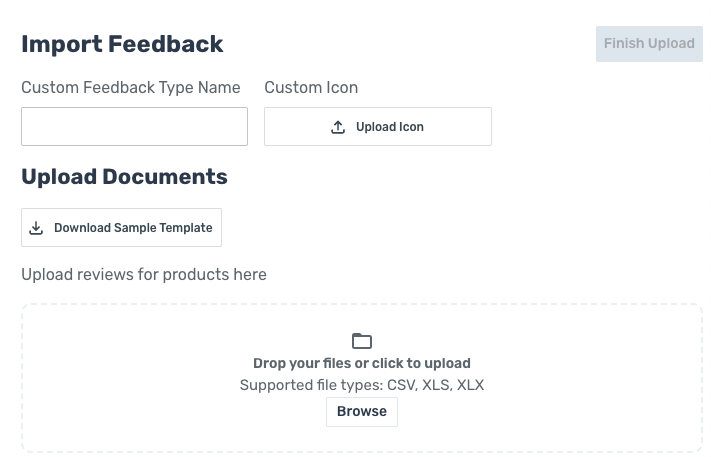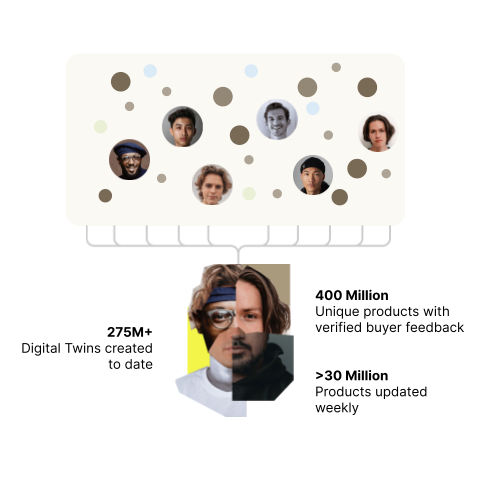AI and Natural Language Processing
AI-powered customer feedback so you can take action now
Native AI turns insight into impact
Introducing Native AI, the always-on market intelligence platform that helps you understand, innovate, and create ideal experiences for your customers.

A better way to find the answers you need
Create impact through measurable improvements to products, customer experience, and marketing.
-
Analyze millions of qualitative and quantitative data points
-
Automate product and keyword tracking across the web
- Converse with digital clones of your customers in real-time
Insights Dashboard
Customize and export reports with full choice of visualizations. Set up alerts for specific products and keywords, and monitor trends over time in order to predict future consumer behaviors and identify white-space opportunities.


Bring Your Own Data
Upload your first party data in any structured or unstructured format. Our platform is compliant with international data processing regulations to eliminate unnecessary risk.
Digital Twins
Converse with digital clones of your customers or your competitors' customers. Filter by demographic, purchase channel, behavior, and more. Create visualizations and export your results.

Expert White-Glove Service
Our platform is designed for you to be successful independently, but we're here to make sure you’re able to take full advantage of the value Native AI provides.
The Native AI Difference
We're not like other all-in-one insights platforms. Get a peek under the hood.
Data Safety & Privacy
Advanced Orchestration
Synthetic Output Controls
AI and Natural Language Processing
The intersection of artificial intelligence and natural language processing signifies a fascinating paradigm shift in the world of technology. This partnership promises to revolutionize how humans and machines communicate, opening up an array of applications in various spheres of life. By employing computational techniques to glean insights from the human vernacular, it translates human languages into understandable, machine-friendly code, thereby facilitating computer programs that are more instinctive, smooth, and personalized.
How, exactly, does natural language processing work? Natural language processing, or NLP, combines computational linguistics with artificial intelligence to process and understand human language. NLP algorithms are designed to discern, decipher and understand the nuances and intricacies of human language, from syntax and semantics to sentiment and intent. These algorithms are then employed in AI systems, thereby enabling them to comprehend and utilize human linguistics.
This computational capacity is ingrained within many AI systems we use in our everyday life. It's present in our smartphone assistants, our email services, and in countless industries, bridging the gap between human and machine. On a more macro scale, it's at the heart of machine translation services, comprehension of speech in hearing aids, sentiment analysis for social media monitoring, and so much more.
Understanding this intricate partnership between AI and natural language processing demands a structured approach. Numerous resources exist online for those keen about acquiring competence in this domain. Among those, the most accessible include online platforms like Coursera and Stanford University that offer comprehensive courses on the topic. The natural language processing course at Stanford is highly acclaimed for its rigorous and in-depth approach to the subject matter.
Emphasizing practical relevance alongside comprehensive theoretical understanding, these online courses equip one with the requisite skills to operate in the field. Through varied exposure to natural language programming, one can delve into the fascinating world of what is “natural language” and how it's deciphered and processed in AI.
Meanwhile, it's essential to differentiate between AI and the natural language processing subset within it. In simple terms, AI focuses on mimicking human intelligence and decision-making capacity. In contrast, natural language processing deals with comprehension, articulation, and generation of human language by a machine. As more advanced AI systems are being developed, natural language processing is becoming increasingly crucial in enhancing communication between people and machines, ensuring a smoother and more intuitive interaction. In essence, the exploration of AI and natural language processing offers a candid viewpoint into the future of human-machine interactions.
NLP Applications
Natural Language Processing (NLP) has been touted as one of the most exciting fields of artificial intelligence (AI), providing transformative advantages that are changing several industries. The crux of NLP, essentially, lies in AI's ability to understand, interpret, and generate human language in a way that is both meaningful and useful.
Immersive examples of NLP applications validate not only the potential of this technology but also the practical efficacy of its application in real-life scenarios. For instance, customer service bots using NLP effectively handle customer queries round the clock with minimum human intervention. And virtual assistants, such as Siri and Alexa, have incorporated NLP to comprehend and respond to user commands.
Revolutionary NLP applications in education are found in the design of Intelligent Tutoring Systems (ITS). These systems leverage the power of NLP in facilitating personalized learning experiences, analyzing student inputs, providing feedback, and improving overall educational outcomes. Providing an edge in individual learning, NLP has bolstered the educational sector.
Moreover, perhaps one of the most life-altering applications of NLP lies in healthcare. NLP applications in healthcare include processing and understanding patient medical records to facilitate diagnoses, analyze treatment patterns and predict health-related outcomes with improved accuracy and precision.
As we continue to explore the wide-ranging implications of NLP applications in AI, it isn't hard to envision a future where the human-computer interface is embellished with human-like textual understanding and response capabilities. This fusion of human and machine interaction, aided by NLP, is significant as we progress in the Information Age.
Natural Language Processing Examples
There is a wide range of applications for Natural Language Processing in real-life contexts. NLP has been gradually transforming the face of digital communication, thereby eliminating barriers and crafting smoother interactions between machines and humans. One of the remarkable features of Natural Language Processing revolves around its ability to comprehend human language, absolving it of its inherent complexity and ambiguity.
Diving deeper into Natural Language Processing examples, there are myriad applications that mark their prominence in our lives. One such application is virtual personal assistants like Siri and Alexa, which employ NLP for effective communication with users. These smart assistants understand and execute user commands, a function aided by NLP's algorithms.
Further illustrating Natural Language Processing examples in AI, we can discuss the role of NLP in AI-powered translation services. These services are designed to provide translations between languages, comprehending the nuances and context of the language, thereby bridging linguistic gaps across global communication.
Even more exciting are the Natural Language Processing example projects and open source programs available to the developer community. Encompassing everything from sentiment analysis to spam detection within emails, these projects demonstrate an expansive and practical use of NLP in different sectors. These sample applications can form a baseline for future development. Whether it's Python-based tutorials with comprehensible code snippets or PDF guides explaining NLP's theoretical aspects, these resources can be an invaluable tool.
To conclude, we can affirm that the utilization and versatility of Natural Language Processing are widespread. From its prevalent usage in AI to its diverse features such as understanding human language in its natural form, NLP continues to link human communication to computers in a seamless and sophisticated manner.
